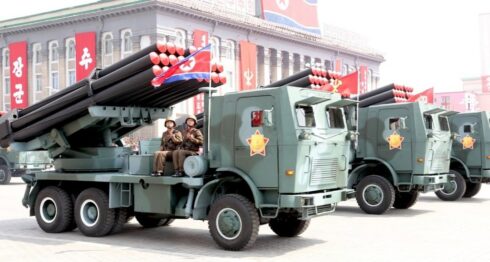The first confirmed combat use of North Korea’s 240-mm M1991 multiple rocket launcher system (MLRS) by Russian forces has been documented near the frontlines in Ukraine. This follows earlier sightings of North Korean 170-mm M1989 Koksan artillery guns, indicating a growing reliance on Pyongyang’s heavy firepower to bolster Russia’s offensive capabilities.
Recent footage shows Russian troops installing anti-drone cages on the M1991, a clear adaptation to the evolving battlefield where FPV drones dominate. Unlike previous leaks, this video appears to have been deliberately released as part of a broader propaganda effort—especially after Moscow’s recent acknowledgment of North Korean troops fighting in Kursk region. LINK
Developed in the 1980s as a counterpart to the Soviet BM-27 Uragan, the M1991 fires 5.2-meter rockets weighing 400 kg, each carrying a 90-kg warhead. A single launcher can unleash 22 rockets in under a minute, saturating targets 40-60 km away (with reports suggesting newer variants may reach 80 km). The system is compatible with thermobaric, cluster, and high-explosive munitions, making it a dangerous addition to Russia’s arsenal.
Their deployment suggests Moscow is using North Korean stockpiles to offset domestic production shortages while preserving more advanced Russian-made systems for critical operations. While the M1991 is older and less precise than modern Russian MLRS like the Tornado-S, its sheer volume of fire compensates for its technological limitations. Given North Korea’s vast stockpiles, these systems could soon become a common sight across the front, further internationalizing the conflict’s arms supply chain.







it has cute eyelashes. a true femme fatale
trump said yesterday: biden started this ukraina-russia war, let biden finisht it. why i must stop the war which i have not started” it means,
more 3 years will contunie war at least
if ukraine can use us himars , then russia can use nk mlrs systems . looks like nk is deployment , testing and supply lines are improved . are nk drones next ?
if usnato can bomb belgrade for kosovo then certainly, russia can bomb kiev for the donbass.
i mean, it’s elementary, dear watson.
north korea superior to hillbilly amerikan–our lgbt weapons rejected by pygmy special forces
just love they still say russia is running out of ammo, artillery and rockets among everything else. i would say that nk is trying there stuff out in a real war to see how it is really works. training just goes so far but a real war is the real thing!
russ is not dumb they are saving the advance weapons for the nato cowgirls. they are either aware of a future first strike by nato or have a plan for their own first strike and ramping up reserves and stock pile while using up old amo and equipment in ukraine.
more nk soldiers to the kursk front please
north korean has become a valuable allie in a time when western ambition has become confrontational to the point of a high risk war.
russia gave the west a sobering taste of what a third world war would look like. what alliances and dynamics would present themselves in case of a direct, hot war versus nato.
if it is a fight that the americans want it is one that they will get, to their regret.